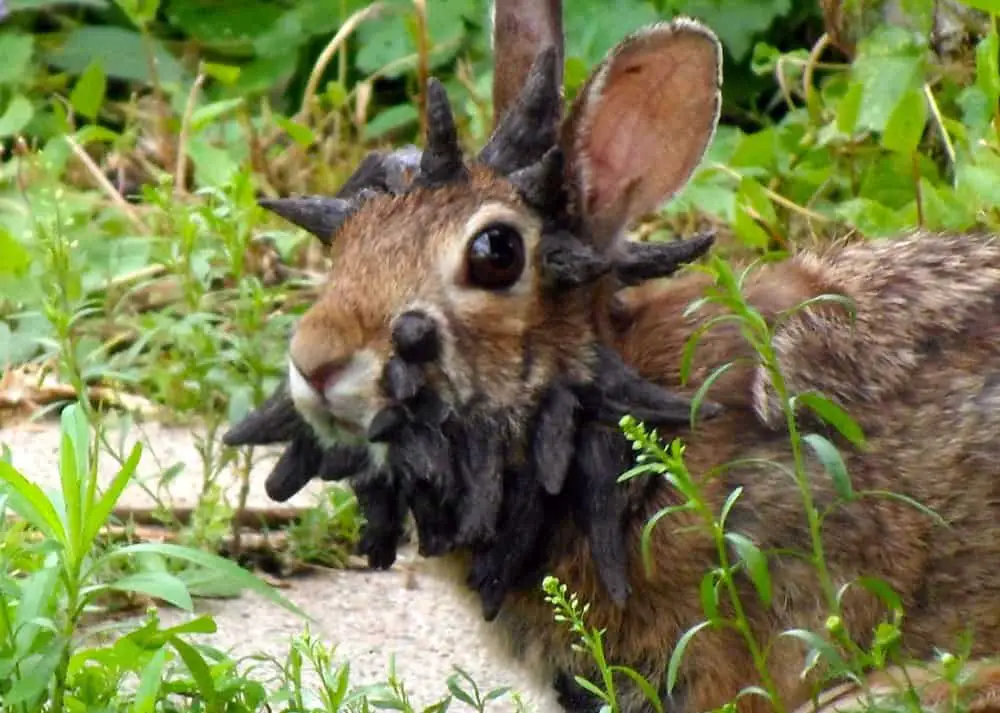Disclosure: We may earn money or products from the companies mentioned in this post.
If you have loved Rabbits for most of your life, you’ve probably heard myths about them. The most common rabbit myth is the Easter Bunny, but those myths don’t stop there! You are here because you’ve heard about rabbits with horns called Jackalopes. Can rabbits grow horns? Let’s find out!
We’ve all seen the pictures, but are Jackalopes real?
Jackalopes are not real, yet they are kind of real. There is even a rabbit with horns in the Smithsonian Museum, but it’s not a Jackalope. Rabbits can grow horn-like appendages, but not like the deer antlers found on most examples of Jackalopes.
The truth is sometimes wild rabbits have horn-like protrusions on their bodies. Some even call them antlers, so it’s understandable how some people can be confused about the truth about Jackalopes.
So, are Jackalopes a myth or not? Are there scientific reasons that rabbits can grow horns?
Let’s find the truth together.

The History Of Jackalopes
The story goes like this: on nights before a thunderstorm, cattle herders of Wyoming would sing to their cattle and be surprised to hear their songs being sung back to them. It is believed that these songs were made by the Jackalopes.
Jackalopes have long been part of American Folklore. You can say it’s like Bigfoot or the Unicorn. Some swore to have seen a Jackalope at one time or another but until now, no one is sure. The Jackalope is also called the “Bunny Frankenstein” and we largely owe it to Douglas Herrick and his taxidermy skills.
You see, in 1932, Douglas Herrick found a dead rabbit on his porch, surrounded by deer antlers from recent hunts. Inspired by the mythical Jackalope he aimed to bring the myth into life…and he did it.
Douglas took the head of the rabbit, used his taxidermy skills to stuff it, and then he sewed on the antlers. Thus, the first-ever Jackalope came to be. I mean, it’s dead and stuffed, but it looked almost as good as the myth itself.

Today, it’s not uncommon to see taxidermied Jackalopes in bars across the country. These are all stuffed rabbit heads and sewn on antlers.
To my personal knowledge, no one has ever really seen a living rabbit with antlers like those of the deer or the moose. But there are for sure, many myth chasers out there that make it their lifelong dream to catch a glimpse of the mythical Jackalope.
Can Rabbits Grow Horns?
Rabbits cannot grow horns but they can grow horn-like appendages. These are not real horns but rather are tumors. This is more common in Eastern CottonTail Rabbits, Jack Rabbits, and even in some European rabbits and is caused by the strain of a virus called the Shope Papillomavirus.
The Shope Papillomavirus is a cousin of the Human Papillomavirus. This zoologic strain was first discovered by Dr. Richard Shope in 1930. His curiosity was piqued when he heard about these rabbits with horns and thus asked a friend if he could procure one of the horns for him to test.

Shope was able to procure a horn and after crushing it, submerged it into a solution and tried to filter it. He then found out that the filter will only let viruses through. This proves his initial hypothesis that viruses can cause tumors.
To prove his hypothesis further, he took some of the crushed horns and rubbed them in the heads of healthy rabbits. These rabbits grew horns too.
He then passed on his findings to another colleague, Francis Rous. Rous, instead of rubbing the crushed horns onto rabbit heads, opted to inject the solution into healthy rabbits. He found out that instead of growing horns, the rabbits developed aggressive cancerous tumors.
This research is so groundbreaking because it proved that there is a correlation between viruses and cancer tumors.
Is the Shope PaPillomavirus Contagious?
If you’ve come across a rabbit infected by this virus, it is valid to ask whether this is contagious to both humans and pet animals.
The Shope Papillomavirus which causes rabbits to grow horn like tumors is not contagious to humans, but it can be transferred to domestic rabbits through tick bites and even through physical contact between the ill and healthy rabbits.
If a tick who has bitten a rabbit with the virus manages to bite your bunny, then your rabbit may get this disease too. Also, know that these horns are not harmless. These are cancer tumors and can be accompanied by other cancer cells. Besides, horns usually grow on rabbit faces and necks and this could greatly affect their quality of life.
Horn-like protrusions in rabbits will hinder them from eating, drinking, playing, or even grooming. Also, aggressive cancers in animals are very costly to cure and are almost always fatal.
Is there a Jackalope in the Smithsonian?
Yes, there is a Jackalope in the Smithsonian…kind of. The Jackalope can be found in the Smithsonian’s Mammal collection.
Years ago, Suzanne Peurach, the museum’s mammal collection manager was shocked to see a Jackalope and had to confirm it’s presence with Robert Hoffman, senior Mammalogist of the Smithsonian and expert in everything rabbit if what she saw was real.
You see, the jackalop in the Simthsonian is actually an Eastern Cottontail rabbit infected with the Shope Papilloma Virus.

Have you ever seen a Jackalope? Share your experience with us!
